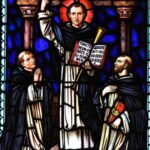
St. Peter Chrysologus
St. Peter Chrysologus
When they lived:
St. Peter Chrysologus, also known as “Peter of the Golden Words,” lived during the late 4th century and the early 5th century. He was born around 380 AD and died in 450 AD.
Where they lived:
St. Peter Chrysologus lived in the city of Ravenna, which was the capital of the Western Roman Empire at that time. Ravenna is located in present-day Italy and was a major political and cultural center during his lifetime.
Notable world events during the time of their life:
- Fall of the Western Roman Empire (476 AD): Although St. Peter Chrysologus did not witness this event himself, he lived during the decline of the Western Roman Empire, and its eventual fall to Odoacer in 476 AD marked the end of ancient Roman rule in the Western Mediterranean.
- Sack of Rome by the Visigoths (410 AD): In 410 AD, the Visigoths, led by Alaric, famously sacked the city of Rome. This event shocked the Roman world and had profound cultural and historical implications.
- Council of Ephesus (431 AD): The Council of Ephesus, which took place during St. Peter Chrysologus’s lifetime, addressed theological disputes, including the nature of Christ. It affirmed the title of the Virgin Mary as “Theotokos” (Mother of God), a significant development in Christian doctrine.
- Life of St. Augustine (354-430 AD): The influential theologian and philosopher St. Augustine of Hippo lived during a significant portion of St. Peter Chrysologus’s life. Augustine’s writings had a lasting impact on Christian thought and theology.
- The Fall of Carthage (439 AD): Carthage, a major city in North Africa, fell to the Vandals in 439 AD, further contributing to the fragmentation of the Western Roman Empire.
Their patronage:
St. Peter Chrysologus is recognized as a Doctor of the Church and is known for his eloquent and concise preaching, earning him the nickname “Chrysologus,” which means “Golden Words.” He is the patron saint of preachers and is celebrated for his ability to convey complex theological concepts in simple, understandable language. His sermons have been admired for their clarity and pastoral wisdom, making him a model for clergy and theologians. Additionally, he is often invoked by those seeking inspiration for effective communication and public speaking.
St. Peter Chrysologus’s life and teachings continue to inspire individuals in their pursuit of effective communication and spreading the Christian faith. His legacy as a preacher and theologian remains influential in the Catholic Church to this day.
Trained and Formed by a Bishop
There are only a few known details about the life of St. Peter Chrysologus. He was born around the late fourth or early fifth century in the Italian town of Imola. Sources differ as to whether this occurred around 380 or as late as 406. He was known for testifying courageously to the full humanity and divinity of Jesus Christ during a period of confusion over the doctrines of the Catholic Church.
Peter’s biography was first written by Agnellus in the ninth century and gives very scanty information about him. He was baptized, educated, and ordained a deacon by the Bishop of Imola, Cornelius, whom he greatly admired and regarded as his spiritual father. Cornelius did not only ordain Peter, but he also taught him the value of self-denial and humility. These lessons from his mentor inspired Peter to embrace the life of a monk for many years. He embraced a lifestyle of asceticism, prayer, and simplicity.
Elevated to the Rank of Archbishop
However, Peter’s simple monastic life came to a conclusion after the death of Archbishop John of Ravenna in 430. The clergy and people of Ravenna chose a successor and asked Cornelius, who was still the Bishop of Imola, to go to Rome and ask for the approval of the Pope for the candidate. Cornelius brought Peter, who was still a deacon then, along with him on a visit to Pope Sixtus III, where Peter was declared John’s successor.
The new Archbishop of Ravenna was received warmly by the Western Roman Emperor Valentinian III and his mother, Galla Placidia. His piety, zeal, and excellent preaching won him respect and admiration in his See. However, throughout the metropolitan area, Peter encountered the surviving remnants of the pagan religion along with the various abuses and distortions of the Catholic faith. With utmost zeal and pastoral care, he curbed these abuses and evangelized non-Christians during his leadership in Ravenna.
Defending the Faith Against Heresies
One of the major erroneous teachings of Peter’s time was monophysitism. This belief held that Jesus Christ did not possess a distinct human nature in union with His eternal divine nature, even though He took on an earthly and human body with its cycle of birth, life, and death. Peter greatly labored to prevent the westward spread of this heresy, which was promoted by the monk Eutyches from Constantinople. After the Synod of Constantinople in 448 condemned this monk, Eutyches endeavored to gain the support of Peter, but without success.
Besides his courageous defense of the Catholic faith and its doctrines, Peter also made improvements to the city’s cathedral. He also built several new churches. He addressed a significant letter to Eutyches, emphasizing the authority of the Pope in the monophysite controversy.
In anticipation of his death, Peter returned to Imola. In the year 450, one year before the Church’s official condemnation of the heresy of monophysitism, Peter Chrysologus died. He is credited as the author of around 176 surviving homilies, which contributed to his later proclamation as a Doctor of the Church. His feast day is July 30.

Five Interesting Facts About St. Peter Chrysologus
- St. Peter was given the title Chrysologus,” which means “golden speech” or “golden-worded” in Greek.
- In 1729, because of his very short but theologically rich homilies, St. Peter Chrysologus was distinguished as the “Doctor of Homilies”.
- Some of St. Peter Chrysologus’ surviving works offer eloquent testimony to the Church’s traditional beliefs about Mary’s perpetual virginity, the penitential value of Lent, Christ’s Eucharistic presence, and the primacy of St. Peter and his successors in the Church.
- In Christian art, St. Peter Chrysologus is depicted with a dog at his feet, a bishop’s staff, or a beehive.
- One of St. Peter Chrysologus’ famous dictums is “If you jest with the devil, you cannot rejoice with Christ.”
Prayer to St. Peter Chrysologus
O God, who made the Bishop Saint Peter Chrysologus an outstanding preacher of your Incarnate Word, grant, through his intercession, that we may constantly ponder in our hearts the mysteries of your salvation and faithfully express them in what we do. Through our Lord Jesus Christ, your Son, who lives and reigns with you in the unity of the Holy Spirit,God, for ever and ever Amen.



